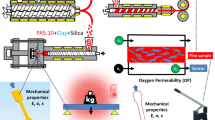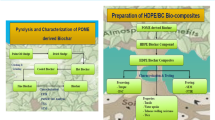Abstract
Polyethylene terephthalate (PET) consumption, in particular, is one of the most commonly available plastic wastes and has the fastest growth rate in the global plastic market. Its disposal has become a serious challenge globally since it is non-biodegradable. In this study, recycled PET and activated carbon (AC) derived from a biomass material (orange peels) were selected as feedstocks for the synthesis of an agro-derived PET-AC biocomposite for use in fuel cells. Five samples of the PET-AC mix ratios of 10:90%, 30:70%, 50:50%, 70:30%, and 90:10% compositions for each of the two AC samples prepared by different treatment methods (chemically and thermally) were used to form thin PET-AC films upon drying. Results from the water absorption trend and mechanical (textural and flexural) behaviors revealed that samples produced by chemically activated AC were observed to produce biocomposites with improved characteristics, ideal for use as a low-cost alternative electrode material than the physically (steam) activated AC in the surface modification of PET. This shows the effect of preparation method on the properties of the PET-AC composite. In addition, the surface modification of PET using activated carbon from orange-peel biowastes has offered a better eco-friendly way of disposing of waste.
















Similar content being viewed by others
Data Availability
Data available within the article and supplementary section of the article, more details would be made available on request via corresponding author.
References
Yuan X, Kumar NM, Brigljević B, Li S, Deng S, Byun M, Lee B, Lin CS, Tsang DC, Lee K, Chopra SS, Lim H, Ok YS (2022) Sustainability-inspired upcycling of waste polyethylene terephthalate plastic into porous carbon for CO2 capture. Green Chem 24:1494–1504. https://doi.org/10.1039/D1GC03600A
Adelaja OA, Keshavarz KG (2017) Treatment of phenanthrene and benzene using microbial fuel cells operated continuously for possible in situ and ex situ applications. Int Biodeter Biodeg 11(6):91–103
Subramani M, Sepperumal U (2016) FTIR analysis of bacterial mediated chemical changes in Polystyrene foam. Ann Biol Res 7(5):55–61
Hussin F, Aroua MK, Kassim MA, Ali UF (2021) Transforming Plastic Waste into Porous Carbon for Capturing Carbon Dioxide: A Review. Energies 14(24):8421. https://doi.org/10.3390/en14248421
Song C, Zhang B, Hao L, Min J, Liu N, Niu R, Gong J (2022) Converting poly(ethylene terephthalate) waste into N-doped porous carbon asCO2 adsorbent and solar steam generator. Green Energy Environ 7(3):411–422. https://doi.org/10.1016/j.gee.2020.10.002
Benyathiar P, Kumar P, Carpenter G, Brace J, Mishra DK (2022) Polyethylene Terephthalate (PET) Bottle-to-Bottle Recycling for the Beverage Industry: A Review. Polymers 14:2366. https://doi.org/10.3390/polym14122366
Zhao Yi-Bo Z, Xu-Dong L, Hong-Gang N (2018) Solvent-based separation and recycling of waste plastics. Chemosphere 209:707–720
Roizard C, Vivien A, Al Shehimy A, Reynard-Feytis Q, Kahlfuss C (2022) Photo redox Processes in the Aggregation and Gelation ofElectron- Responsive Supramolecular Polymers Based on Viologen. ECS Adv 1:020502
Abbas Q (2019) Understanding the UV-Vis Spectroscopy for Nanoparticles. J Nanomater Mol Nanotechnol 8:1–3. https://doi.org/10.4172/2324-8777.1000268
Hamid A, Rahmawati Z, Abdullah M, Purbaningtyas TE, Rohmah F, Febriana ID (2022) The Influence of NaOH Activator Concentration on the Synthesis of Activated Carbon from Banana Peel for Pb (II) Adsorption. EKSAKTA: Berkala Ilmiah Bidang MIPA 23(03):158–166
Ramutshatsha-Makhwedzha D, Mbaya R, Mavhungu ML (2022) Application of Activated Carbon Banana Peel Coated with Al2O3-Chitosan for the Adsorptive Removal of Lead and Cadmium from Wastewater. Materials 15:860. https://doi.org/10.3390/ma15030860
El-Nemr MA, Hassaan MA, Ashour I (2023) Fabrication of N-doping activated carbons from fish waste and sawdust for Acid Yellow 36 dye removal from anaquatic environment. Sci Rep 13:1
Kanjana K, Harding P, Kwamman T, Kingkam W, Chutimasakul T (2021) Biomass-derived activated carbons with extremely narrow pore size distribution via eco- friendly synthesis for supercapacitor application. Biomass Bioenergy 153:106206
Hassan MI, Kadir AA, Arzlan IS, Tomari MR, Mard N, Hassan MF, Abdullah MM, Nabiałek M, Jeż B (2022) Recycling of PET Bottles into Different Types of Building Materials: A Review. Arch Metall Mater 67(1):189–196. https://doi.org/10.24425/amm.2022.137488
Xu C, Hu Z, Wang X, Wang W, Dejuan Huang K, Qian Y (2021) Facile Preparation of Hierarchical Porous Carbon from Orange Peels for High-Performance Supercapacitor. Int J Electrochem Sci 16:210350
Somwanshi DK, Sharma VP, Sharma S, Jain K (2022) A Literature Review on Mechanical Properties of Waste PET Bottle Based Fibre. IOP Conf Series: Earth Environ Sci 1084:012069. https://doi.org/10.1088/1755-1315/1084/1/012069
Babaremu KO, Okoya SA, Hughes E, Tijani B, Teidi D, Akpan A, Igwe J, Karera S, Oyinlola M, Akinlabi ET (2022) Sustainable plastic waste management in a circular economy. Heliyon 8:e09984
Deshmukh S, Topare NS, Raut-Jadhav S, Thorat PV, Bokil SA, Khan A (2022) Orange peel activated carbon produced from waste orange peels for adsorption of methyl red. AQU––AWater Infrastruct Ecosyst Soc 71(12):1351. https://doi.org/10.2166/aqua.2022.119
Ozpinar P, Dogan C, Demiral H, Morali U, Erol S, Samdan C, Yildiz D, Demiral I (2022) Activated carbons prepared from hazelnut shell waste by phosphoric acid activation for supercapacitor electrode applications and comprehensive electrochemical analysis. Renew Energy 189:1–42
Rustamaji H, Prakoso T, Devianto H, Widiatmoko P, Kurnia KA (2023) Facile synthesis of N, S-modified activated carbon from biomass residue for promising supercapacitor electrode applications. Bioresource Technology Reports 21:101301
Zhou, Y., He, J., Chen, R., and Li, X. (2022). Recent Advances in Biomass-derived Grapheneand Carbon Nanotubes https://www.sciencedirect.com/science/article/pii/S2589234722000306
Tezara C, Siregar JP, Lim HY, Fauzi FA, Yazdi MH, Moey LK, Lim JW (2016) Factors that affect the mechanical properties of kenaf fiber reinforced polymer: A review. J Mech Eng Sci (JMES) 10(2):2159–2175
Pham TH (2023) Synthesis of Activated Carbon from Polyethylene Terephthalate(PET) Plastic Waste and Its Application for Removal of Organic Dyes from Water. Non-Metallic Sci 05(01):1–11
Zhang, L. (2010). Carbon-based materials as supercapacitor electrodes. Ph.D. Thesis; National University of Singapore, 70
L Wang, N Xiuyuan, (2017) The effect of the inorganic nanomaterials on the UV-absorption, rheological and mechanical properties of the rapid prototyping epoxy-based
Aradhyula TV, Bian D, Reddy AB, Jeng YR, Chavali M, Sadiku ER, Malkapuram R (2020) Compounding and the mechanical properties of catla fish scales reinforced-polypropylene composite–from biowaste to biomaterial. Adv Compos Mater 29(2):115–128
Alzuhairi MA, Ahmed MH, Al-Ghaban SN, Almutalabi N (2016) Chemical Recycling of Polyethylene Terephthalate (PET) as Additive for Asphalt. ZANCO J Pure Appl Sci 28(2):675–679
Daramola OO, Akintayo OS, Adewole TA, Talabi HK (2017) Mechanical properties and water absorption behaviour of polyester/soil-retted banana fibre (srbf) composites. Ann Faculty Eng Hunedoara: Int J Eng, Tome 15(1):183–190
Funding
Selves.
Author information
Authors and Affiliations
Contributions
All authors contributed to the study conception and design. Material preparation was done by OAA, data collection and analysis were performed by DU and OAA. The first draft of the manuscript was written by BRB, BJO and all authors commented on previous versions of the manuscript. All authors read and approved the final manuscript.
Corresponding author
Ethics declarations
Conflict of interest
The authors have no relevant financial or non-financial interests to disclose.
Supplementary Information
Below is the link to the electronic supplementary material.
Rights and permissions
Springer Nature or its licensor (e.g. a society or other partner) holds exclusive rights to this article under a publishing agreement with the author(s) or other rightsholder(s); author self-archiving of the accepted manuscript version of this article is solely governed by the terms of such publishing agreement and applicable law.
About this article
Cite this article
Adelaja, O.A., Udorah, D., Babaniyi, B.R. et al. Development of PET-AC Composite: Effect of Preparation Method on the Mechanical and Water Absorption Behaviours. Chemistry Africa 7, 1547–1562 (2024). https://doi.org/10.1007/s42250-023-00852-8
Received:
Accepted:
Published:
Issue Date:
DOI: https://doi.org/10.1007/s42250-023-00852-8




